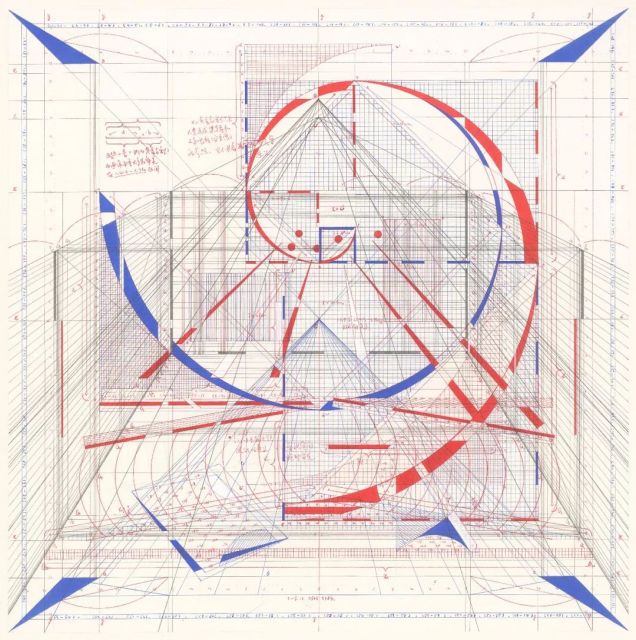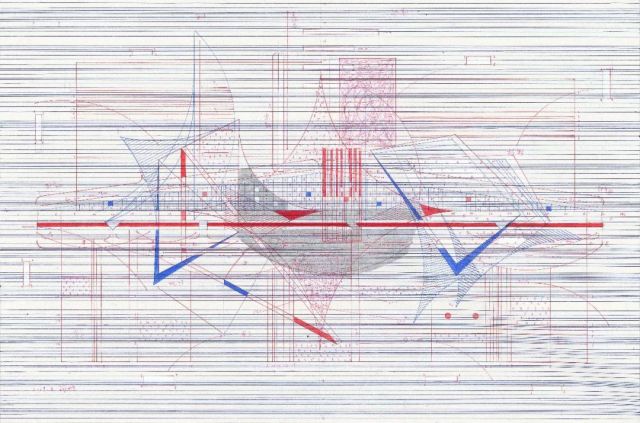
Branch, the exhibition topic, aims to emphasize the generation and development of one's working method. During continuous creation and practice, the cognition and concept of artists diverge like branches and grow constantly, and form a working method gradually that not only sticks to the subject value, but also diverges and extends continuously. The abstract space created by Ling Haipeng with ruler painting technique depicts the personal psychological landscape of the artist, and is also the technique inheritance and contemporary experiment of traditional ruler painting.
Preface
Text by Wang Jiang
We were especially restrained during our visits to the studio of Ling Haipeng for fear of messing up his life schedule. A bed, a drawing board, a bookrack and a closet are put in the single room of 7-8 square meters. This is his creation and living space. There are some labels exquisitely arranged on the wall, demonstrating his mind recorded in words. The drawing board faces south and adjoins the window, which not only brings in natural light, but also extends the narrow sight of the working space. Looking out from the light blue sheer curtain, we can find the line of heaven and earth in the distance. This enables people to think of the spatial scene in his painting, and spontaneously guess the motivation and will of his creation theme.
In addition to pen and ink, a self-made ruler is the most eye-catching tool on his drawing board. This is the ruler used to lead the ruler painting. “Dexterous tower” is seen as ruler painting, and as one of the thirteen branches of traditional Chinese painting, it demonstrates the persistence of ancient Chinese in creation method. Its contents can be the depiction of market place, such as Riverside Scene at Qingming Festival of Zeduan ZHANG, be heaven and earth, such as Yueyang Tower of Yong XIA, and also be royal scene, such as Auspicious Cranes of Emperor Huizong. Most of the classical works in the history are mixed and matched with mountains and rivers, figures, flowers and bird. “Mountains and waters are on the top part, with ruler painting as the render”. The tradition of Chinese scholars who valued meaning often despised the originality of ruler painting, and the improperness of modern building type and traditional style makes the contemporary promotion of ruling painting extremely difficult.

Ling Haipeng, Boring Proofs, 2019; Chinese Ink on Paper, 68x68cm

Ling Haipeng, Dropped Clue, 2019; Chinese Ink on Paper, 68x68cm
As ruler painting fades away, has the working method of Haipeng LING generated new possibilities? Distinctively from traditional experience, he has given up the description of figurative landscape from theme, and turned to construct abstract space. Coordinates, perspectives, end points and figures gather together in his frames and constitute the spatial relationship of painting. They also condense to a kind of superorganic tractive force. This is the integration of soar idea with rigorous originality and the meaning-valuing feeling of pursuing for talking with classic scholars with superorganic aesthetics. The ruler painting technique is dissociated from the restriction of aesthetic segment, so as to expand the expressive force of language. Then, should it refer to the form spectrum of western art history to find its value coordinates? What is the relationship between it and “cold abstract” painting? From the Dutch style to Russian conciliarism, and then to minimalism, we can see the process of form extraction and erasion to the largest extent, and the image of the world reduces to cold geometry until there is no meaning left. But the paintings of Haipeng LING maintain distance from this vein of western art history. Based on the logic of methodology, we can find that the paintings of Haipeng LING have reserved certain degree of automatic writing, and he started work under initial presupposition, resort to the extension of perception to draw the outline of details, and tried to summarize and define the direction of each kind of graphic combination. Therefore, the paintings of Haipeng LING are constantly promoted in the coding of visual perception, and indicate a symbol system that is generated. In the meantime, he builds a meditation field corresponding to his spirit via point, line, plane and other abstract factors. For him, creation, mediation and daily life have been intertwined with each other, and it is difficult to clarify completely. In addition, perceptual words appear in his paintings. The words of statement, judgment, definition and reminiscence disclose the cognition and mental change of the author, and become the return visit of Haipeng LING to the inscription tradition of Chinese painting and also the channel to understand his creation idea.

Ling Haipeng, Ancient Join Forces 01, 2019; Chinese Ink on Paper, 68x68cm

Ling Haipeng, Frustrated, 2019; Chinese Ink on paper, 45x68cm
The
record of daily perception underpins the continuous work of Haipeng
LING, and each work looks like the visualized mental note. In his ideas,
the Pythagoras philosophical concept is close to his realization and
statement of the world. Number, time and space, life and macro themes as
such become lines, geometry and arrays in his paintings, and try to
build a set of ideographic logic based on visual perception. Haipeng
LING believes in and insists on that his work is the consideration and
presentation of the essence of life. Just like the metaphor of
“Divergence” of branches in the exhibition topic, we can quietly observe
the generation process of the abstract language system in the working
method that not only sticks to subject value, but also diverges and
extends continuously.
About the artist
Ling Haipeng was born in Liao Ning, China in 1987 and graduated from Lu Xun Academy of Fine Arts. He is now living in Beijing as an independent artist. He focuses on using the skills of ruler painting, reintroducing things from the perspective of calculation and model construction, implanting tradition, and explaining "traditional related" issues in a way that takes away traditional aesthetics. Many works have been collected by art institutes such as Art Museum of Lu Xun Academy of Fine Arts, Yixuan Art Museum, New Star Art Museum, E LAND group of South Korea and private collections.
About the curator
Wang Jiang, planner and producer of contemporary arts. He has been committed to the establishment and operation of independent art space since 2014,engaged in the supervision, planning, host of museum and gallery, as well as the instant comment of exhibitions. Wang Jiang’s art concept is deeply influenced by Pierre Bourdieu’s art sociology, breaking the limitations of identity politics in creation and curation by activating the initiative and relativity of self-identity. He uses skepticism as dialectical tool, employing rich forms and media to pose questions to the status quo of the existing art system. Most of his actions start from the criticism of art system and cultural distinction, exploring the new distribution of conceptual art in Internet media, seeking for the creative practice that influences the existing art system.
dRroom is an art project launched by Platform China Contemporary Art Institut in October 2016. It explores and reflects on the new possibilities of art in the context of modern life through the interactive behavior based on physics and virtual space.
About the exhibition
Dates: Jan 5, 2020 - Mar 6, 2020
Venue: Platform China dRoom
Courtesy of Platform China dRoom, edited by Sue/CAFA ART INFO




























